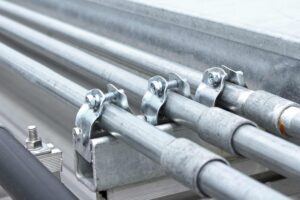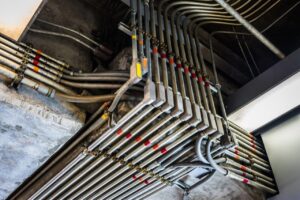When it comes to protecting electrical wiring, underground electrical conduits play a crucial role. They shield cables from environmental factors like moisture, soil movement, chemicals, and physical damage, ensuring safe and efficient delivery of electricity. Whether you’re planning a residential project or managing large-scale commercial installations, choosing the right conduit type is essential. This guide will explore the various types of underground electrical conduits, weigh their pros and cons, and provide tips to help you make an informed decision.

What Are Underground Electrical Conduits, and Why Are They Important?
Underground electrical conduits are protective tubing or piping systems designed to house and safeguard electrical wiring. These conduits ensure that cables remain functional and secure, even in challenging environments. By preventing exposure to weather conditions, shifting soil, and potential damage from rodents or machinery, underground conduits contribute to long-term safety and reliability.
Electrical systems are the lifeline of modern infrastructure. Poorly protected wirings can lead to hazards like short circuits, power outages, or even electrical fires. Conduits not only enhance the durability of wiring but also make repairs or upgrades easier by providing a dedicated pathway for wires.
Benefits of Using Underground Electrical Conduits:
- Safety: Protects people and property from potential electrical hazards.
- Durability: Shields wiring from environmental wear and tear.
- Ease of Maintenance: Simplifies repair or replacement of cables.
- Compliance: Meets building codes and safety regulations in most jurisdictions.
Types of Underground Electrical Conduits
Understanding the different materials and designs available in underground electrical conduits can help you select the right one for your project. Below are some of the most commonly used options.
1. PVC Conduit
Polyvinyl chloride (PVC) conduits are widely used due to their versatility and affordability.
Advantages:
- Corrosion Resistance: Immune to rust or chemical damage, making them ideal for various environments.
- Lightweight: Easier to transport and install compared to metal alternatives.
- Cost-Effective: One of the most budget-friendly options on the market.
- Non-Conductive: PVC conduits provide added safety by reducing the risk of electrical shocks.
Disadvantages:
- Brittle in Cold Weather: Over time, PVC may crack in extreme winter climates.
- Limited Impact Resistance: Less durable against physical force or heavy loads.
2. Rigid Metal Conduit (RMC)
RMC is a heavyweight galvanized steel or aluminum conduit that’s known for its strength.
Advantages:
- Exceptional Durability: Sturdy enough to withstand severe physical impacts.
- Fire Resistance: Offers a high level of protection against high temperatures and flames.
- Versatile Applications: Suitable for both underground and above-ground installations.
Disadvantages:
- High Cost: Significantly more expensive than PVC or plastic conduits.
- Complex Installation: Requires specialized tools and considerable effort during installation due to its weight.
3. Intermediate Metal Conduit (IMC)
IMC is a lighter version of RMC, with the same galvanization process but thinner walls.
Advantages:
- Reduced Weight: Easier to handle and install compared to RMC.
- Durable: Maintains strong resistance to external damage, albeit slightly less robust than RMC.
- Cost-Efficient: More economical than RMC while retaining key benefits.
Disadvantages:
- Limited Flexibility: Not suitable for applications requiring curved installations.
- Corrosion Potential: Despite galvanization, long-term exposure to certain environmental conditions can lead to rusting.
4. High-Density Polyethylene (HDPE)
HDPE conduits are flexible plastic pipes that have gained popularity for underground installations.
Advantages:
- Flexibility: Can be bent without the risk of snapping, making it ideal for challenging layouts.
- Durable in Harsh Environments: Resistant to chemicals, moisture, and soil shifts.
- Lightweight: Like PVC, HDPE is easy to transport and install.
- Long Lifespan: Minimal maintenance is needed once installed.
Disadvantages:
- Higher Material Cost: More expensive than standard PVC.
- Less Impact-Resistant: Does not offer the same level of protection as metal conduits in physically demanding locations.
Factors to Consider When Choosing a Conduit
Selecting the right conduit type depends on several factors. Here’s what you should weigh during your decision-making process:
1. Environmental Conditions
- For wet or chemical-rich environments, opt for HDPE or PVC due to their excellent resistance to moisture and corrosion.
- If the installation area is prone to physical impact, choose metal conduits like RMC for added durability.
2. Budget
- PVC is the most affordable option and is perfect for small-scale projects. However, you may have to compromise on its strength compared to metal or HDPE conduits.
3. Installation Requirements
- For simple underground bends or routes, HDPE stands out due to its flexibility.
- Use IMC or RMC in projects requiring high structural protection, especially in commercial or industrial applications.
4. Building Codes and Regulations
- Always consult local electrical safety codes, as specific conduit types might be mandated for certain projects or applications.
Tips for Installing and Maintaining Underground Electrical Conduits
Proper installation and upkeep of underground conduits are essential for maximizing their performance and longevity. Here are some best practices to follow:
- Plan the Layout Carefully:
-
- Map the conduit path to avoid future disruptions from construction or landscaping work.
- Use the Right Tools:
-
- Invest in high-quality couplings, fittings, and sealing methods to ensure watertight connections.
- Test the Soil:
-
- Conduct a soil analysis to assess risks like shifting or chemical composition that could impact conduit integrity.
- Inspect Regularly:
-
- Schedule routine inspections to identify and repair damage caused by corrosion, soil movement, or external forces.
- Avoid Sharp Bends:
-
- For rigid conduits, avoid excessive bending, as tight curves can strain the material or cables inside.
Wrapping Up
Selecting the right underground electrical conduit is a vital step in protecting and managing an electrical system. Whether you choose the versatility of PVC, the durability of RMC, the cost-efficiency of IMC, or the flexibility of HDPE, your decision should consider environmental conditions, budget, and local regulations. Proper installation and maintenance further ensure that your electrical wiring operates safely and efficiently for years to come.
Remember, the safety and reliability of your electrical systems depend heavily on this choice. Take the time to evaluate your project needs and invest in the appropriate conduit type to safeguard your infrastructure effectively.
